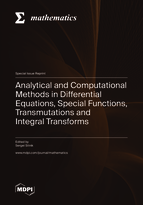Analytical and Computational Methods in Differential Equations, Special Functions, Transmutations and Integral Transforms
A special issue of Mathematics (ISSN 2227-7390). This special issue belongs to the section "Computational and Applied Mathematics".
Deadline for manuscript submissions: closed (30 June 2023) | Viewed by 27324
Special Issue Editor
Interests: differential equations; transmutation theory; integral transforms; special functions; inequalities; numerical methods; approximation theory
Special Issues, Collections and Topics in MDPI journals
Special Issue Information
Dear Colleagues,
This Special Issue is planned to include research papers and surveys which cover a wide range of topics in Computational and Applied Mathematics. High quality papers on the following topics are welcome: differential equations, especially concerning singular solutions and coefficients; transmutation theory with all examples of its applications; integral transforms and special functions theory; classical and advanced inequalities; and numerical methods for all of the abovementioned problems.
Dr. Sergei Sitnik
Guest Editor
Manuscript Submission Information
Manuscripts should be submitted online at www.mdpi.com by registering and logging in to this website. Once you are registered, click here to go to the submission form. Manuscripts can be submitted until the deadline. All submissions that pass pre-check are peer-reviewed. Accepted papers will be published continuously in the journal (as soon as accepted) and will be listed together on the special issue website. Research articles, review articles as well as short communications are invited. For planned papers, a title and short abstract (about 100 words) can be sent to the Editorial Office for announcement on this website.
Submitted manuscripts should not have been published previously, nor be under consideration for publication elsewhere (except conference proceedings papers). All manuscripts are thoroughly refereed through a single-blind peer-review process. A guide for authors and other relevant information for submission of manuscripts is available on the Instructions for Authors page. Mathematics is an international peer-reviewed open access semimonthly journal published by MDPI.
Please visit the Instructions for Authors page before submitting a manuscript. The Article Processing Charge (APC) for publication in this open access journal is 2600 CHF (Swiss Francs). Submitted papers should be well formatted and use good English. Authors may use MDPI's English editing service prior to publication or during author revisions.
Keywords
- differential equations
- transmutation theory
- integral transforms
- special functions
- inequalities
- numerical methods
- approximation theory






